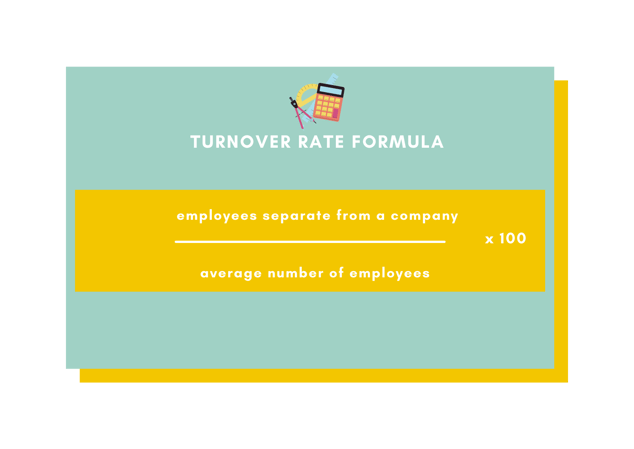Turnover Rate - How to Calculate it?
What is a turnover rate? We’re glad you asked.
Employee turnover rates indicate the percentage of employees who leave a company over a given time period and which often require employers to find a replacement.
Employees turnover all the time, and are doing so at record highs now. Employee turnover can introduce a tremendous financial burden to companies, especially smaller ones, because of the resources required to hire and train replacements. Other factors, like the resources required to maintain the responsibilities of vacant positions, introduce other difficulties. At a high level, there are two types of turnover:
- Involuntary turnover: when an employee is terminated from a position by an employer
- Voluntary turnover: when an employee voluntarily leaves an organization (for any number of reasons)
While employees turnover voluntarily, there are a number of factors that you can control to reduce voluntary turnover (e.g. poor management, lack of growth opportunities, toxic work culture, etc.)
Turnover rates typically do not account for internal transfers or promotions.
Because hiring and training are expensive, it's generally accepted that the lower the turnover rate, the better. And, while it's virtually impossible to prevent turnover entirely, it is certainly something that any employer can help reduce.
Is turnover rate important?
Simply put: yes. In order to effectively manage and reduce the turnover rate, it's first important to understand how often employees leave your company. It offers valuable insights for leadership, process improvement, and overall company culture. Analyzed alongside other key HR metrics in an effective reporting culture, turnover rates can also lead to analyses of the hiring and training processes (and costs) that result from turnover. The Bureau of Labor Statistics reported an average turnover rate of 57.3% in 2021, a figure that further supports the importance of managing turnover.
How to calculate employee turnover rate?
Turnover rate calculations are generally done on a variety of time periods, most typically monthly, quarterly, and annually. The longer time horizons typically uncover more meaningful, and actionable, patterns.
Turnover rates are also often further segmented into areas like turnover at the tenured and new hire levels which makes sense because tenured employees are likely to have lower turnover than new hires. Other segmentations include voluntary and involuntary turnover for obvious reasons.
To calculate the general employee turnover rate, calculate the average number of employees in a given time period (the number of employees at the beginning of that period + the number of employees at the end of that time period, then divide this figure by 2). Then, divide the number of employees separated from the company during that period by the average number of employees. Finally, multiply this figure by 100 in order to calculate your turnover percentage. Here is what the formula looks like:

As we mentioned, there are other turnover rates that you may want to calculate. An example of this would be the first-year turnover rate. To reach this figure, you would simply adjust the formula to only account for separated employees who worked at a company for less than a year, replacing the average number of employees with the total number of separations.
How to reduce employee turnover
Here are some tips for reducing the employee turnover rate:
- Improve your recruitment and onboarding processes: employ tactics that set reasonable expectations with new hires, onboard them well, and make sure that they’re mentored and trained adequately. A stronger hiring process will lead to lower turnover rates.
- Offer a healthy work-life balance: especially now, this is vital in ensuring lower turnover rates.
- Keep salaries competitive: if you don’t have the funds, get creative with things like performance bonuses and incentives. Offering competitive salaries should be specific to each position.
- Make sure there is opportunity for growth: creating training and career progression programs gives employees both the skills and the desire to work harder (and smarter.
- Improve management: invest in managerial training to make sure that managers are good communicators that foster collaboration, inclusion, and reduced turnover.
- Communicate clear KPIs: any strong HR team is data-driven! Check this out for more info.
- Stay in the know: make sure you keep up to date with employees, either through interviews or surveys, to make sure that you identify and address any issues as they arise.
Ultimately, calculating and understanding turnover rates are integral to building a successful business.
Guided analytics for workforce management
Tracking and optimizing key HR metrics, like employee turnover, is one of the most important factors behind driving consistent improvement and workforce optimization (especially in the modern context).
Yet while the importance of data and analytics is widely known and even accepted, today's users aren't getting the value they expect from their investments in analytics.
That's largely because, in our attempt to make analytics fast, powerful, all-seeing, and all-knowing, we've also made them incredibly hard to use. So complex that only experts can make something of their data.
It's vital, therefore, that analytics are made easier for business people (and HR teams). That's what we call Guided Analytics: analytics that assist users in understanding data and using that data to collaborate and drive results.
Some of the things to look for when considering guided analytics for your HR function?
- The ability to enable dashboard and custom visualization builds in just a few clicks: look for ways to instantly visualize, own and understand your HR data.
- A way to aggregate your data from multiple sources in a single source of truth. That might look like connecting your HRMS or payroll software to unify your most important KPIs!
- Securely share insights within your team and across your organization.


